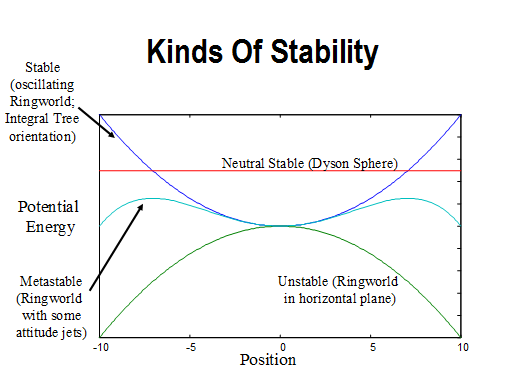
NOTES:
Stability is not the same as equilibrium - for a system to be in equilibrium all forces need to balance, but to be stable, the system has to be robust to small perturbations. A pencil balanced on its point is in equilibrium, but not stable. One on its side is in equilibrium and stable.
This chart shows the different kinds of stability. The lines are potential energy functions. The oscillating Ringworld is as stable in the vertical direction as a ball in a bowl is. Any perturbation simply changes the magnitude of the oscillation. In the horizontal direction though, the Ringworld is completely unstable - any perturbation causes a complete disaster as the Ring tends to get more and more off center. The Dyson sphere is neutrally stable. Any perturbation just moves the Sphere slightly but gives it no tendency to move further along or to return to the original position. Finally, with attitude jets, the Ringworld is probably meta-stable - it will recover from small perturbations, but be vulnerable to a large perturbation. Most systems in the real world are metastable; they will stay put, if they're not pushed too far - just like most people.
It's worth noting that if the impact of light on the shadow squares causes a greater outward force than gravity produces an inward one, then the shadow squares are stable horizontally but unstable vertically. In other words, because the dominant force is outward, not inward, all the signs reverse making stable situations for the Ringworld into unstable ones for the shadow squares and vice versa.
